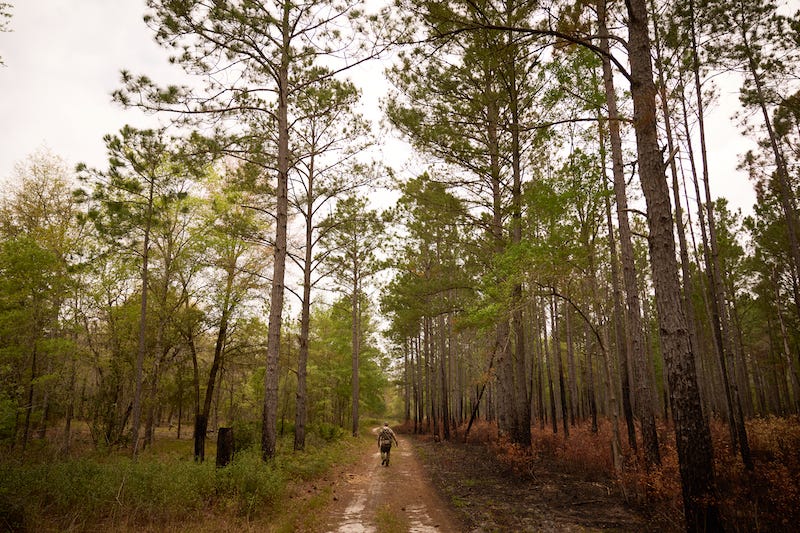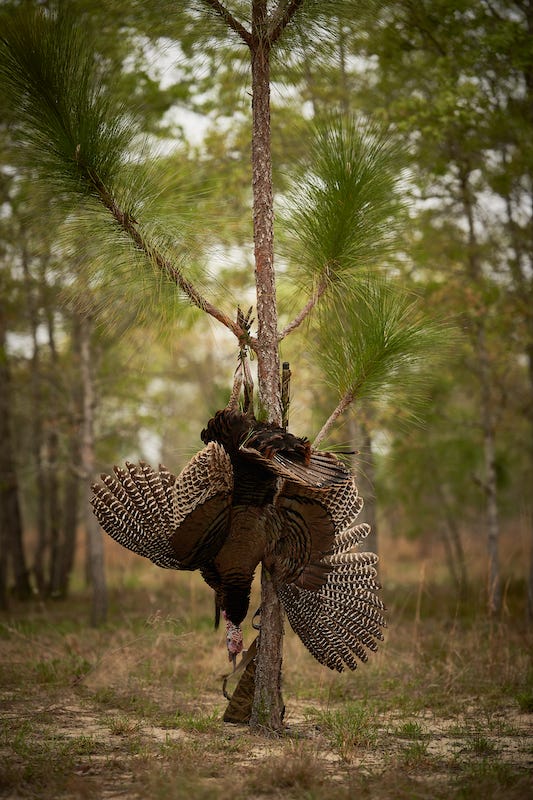Field guide: Wild turkey
A Southern success story turns into a worrying scientific mystery (plus: a recipe from Jesse Griffith's The Turkey Book)
Growing up, “turkey season” for me meant November—that one meal where nearly everyone in the U.S. sits down to slice into a bird. But for those with a more intimate connection with our native turkeys—wild turkeys, or Meleagris gallopavo—the real season has just begun. The hunt is on.
The turkey is not on its face distinctly Southern; it is, after all, sometimes called “America’s bird,” since Ben Frank found it a more suitable national symbol than the bald eagle.1 True to form, wild turkeys can live in almost any kind of forest. But, as chef and hunter Jesse Griffiths notes in his newly released The Turkey Book, “modern turkey hunting history and lore started in the American southeast.”
First, though, before the modern era, there had to be the standard story of ecological tragedy. As white pioneers spread across the continent, hunting for food, hacking down trees, the number of wild turkeys dwindled dramatically. This bird survived only in the hardest-to-reach forest tracts. By the 1930s, their numbers were down to a few hundred thousand, at most. It’s a staggering loss, given that estimates of pre-contact turkey populations are as high as 10 million.
Then, though, the stage was set for a revival. As some tenant farmers gave up on agriculture, land began to return to forest. New laws forbid market hunting. In Virginia, in the late 1920s, biologists began to raise turkeys in pens and then release them into the wild. Unfortunately, these efforts repeatedly failed—for decades. Without a mother hen to teach the birds the ways of the wild, they simply could not survive.
The turkey dinners of my childhood consisted of domestic, farm-raised turkeys—birds descended from a South Mexican subspecies of bird. The Spanish carted some of the birds back to Europe, where new breeds were developed. So if any turkey is all-American, it’s got to be the wild version.
This is a wholly different creature—and a different meat, says Griffiths, a Texas chef and butcher. It’s a rare wild-caught white meat, though it doesn’t always sound to like white meat. He notes that a wild turkey is a proficient flyer; they roost in trees at night to avoid being picked off by predators. Their constant motion means their legs develop more muscle than a domestic turkey ever will. Griffiths told me the meat is deep red, not unlike venison. “Compare this to the pale, plump and pinkish legs of the farmed bird, and the difference is palpable,” he told me.
For hunters who wanted more of those wild turkeys, the answer turned out to be a Southern innovation: the use of a “cannon net,” which could be remotely detonated by a watching hunter to enmesh a wandering bird. The technique was first deployed in a national forest in South Carolina in 1951. The captured birds were relocated to eight locations across the state, and in many cases began to reproduce successfully. So the technique spread. By the dawn of the twentieth century, there were seven million turkeys in the U.S., occupying every state but Alaska.
It’s not quite a happy ending, though, because, like all stories of nature, this one has not reached an end. Biologists estimate that between 2004 and 2014, the wild turkey population fell by a million birds—15%. The dip is particularly pronounced in the South and the Midwest.
What’s going wrong? “We don’t know,” Christopher Moorman, a wildlife ecology professor at North Carolina State University told the Washington Post last year. A new wave of development, turning forests into parking lots? A surge in disease? The rise of coyotes? Could be any of these. And climate change is another hovering worry; one recent study found that turkeys aren’t shifting their nesting times, meaning chicks aren’t always getting the plant buffer and insect smorgasbord they need. There’s a darkly ironic hypothesis, too: that a reduction in the use of DDT has allowed more birds of prey to hunt turkeys.
Once we’ve altered the world, it’s hard to get it back in balance.
Hunting plays a complicated role in this story. Those early biologists were often hunters; the sport was key to the solution. But now, with environmental conditions changing, the amount of hunting the population can tolerate is changing, too. States across the South are tightening turkey regulations, in particular pushing back the opening date—an effort to allow for more reproduction.
The Turkey Book, just released, combines Griffiths’ tales of turkey hunts—including in southeastern Georgia—with his recipes for what to do with all that meat. I recently read the book, alongside an assorted collection of other turkey hunting tales. My takeaway was, mostly, that turkey hunting sounded damn difficult. “There are people who hunt. And there are people who hunt turkeys,” Allison Glock wrote in Garden & Gun back in 2012. “The latter are a special breed. Mostly because turkey hunting is really, really hard.” Griffiths agrees, describing hunting these birds as a “fresh slice of humiliation time after time”—a quote he cribs from Colonel Tom Kelly, a forester who has become known as the poet laureate of the turkey woods.
It’s easy to think of hunting as macho and blood-soaked, but turkey hunting mostly consists of sitting under trees, so long that your limbs go numb. Glock calls it “the hand-knit doily of the hunting genres,” since it includes many intricacies—all the calls and decoys—and endless difficulties.
I read all these stories on a rainy night, while tucked into a cabin in the forests of Mississippi. As I gazed out on the wet woods, I envied the hunters: for me, this was just a vista. (And, given the fact that the trees were tiny spindles, planted perhaps a decade ago, the vista they offered was hardly inspiring.) Griffiths’ chapters are organized around tree species (his Georgia chapter is titled “Eastern Pines”) and in a pithy summary of turkey hunting, he describes the sport as “spending time amongst trees.”
That’s something we all could use more time doing, I think—good for us, and good, for the birds.
Want a taste?
The book left me eager to try wild turkey. By law, the only way that will happen is if some kind turkey hunter wants to invite me over for supper. You’ve got my email.
Griffiths told me that to get the closest possible approximation of the wild flavor, look for a small farm, which, in an unfortunate paradox, it’s more likely the turkey will have room to roam and build up muscle. He particularly recommends looking for heritage breeds like the Narragansett—“a cross of the wily wild Eastern turkey and a domestic bird.” Any slower-growing, smaller-framed heritage turkeys will more closely approximate the wild birds, and can be cooked and enjoyed similarly. (For a Southern farm, my friend Austin Sumrall, the chef at White Pillars—and, soon, Siren Song—in Mississippi, pointed me toward North Carolina’s Joyce Farms.
Ready to cook? Griffiths kindly offered to allow me to publish this recipe for Sunday gravy.
Wild Turkey Sunday Gravy
Serves 8
Using multiple cuts (ground, stuffed breast cutlets and legs) for this slow-cooked bonanza makes for an incredibly rich sauce fit for any Sunday or holiday. Starting with a long-cooked leg quarter to build base-level flavor, you can then add other cuts for contrast and texture. Add wings and necks along with the leg quarter if you like; they’ll add great depth and gelatin. As with any braise, think about building strong foundations: brown the meats carefully to create sweet and caramelized layers. Next, coax as much flavor as possible from the vegetables, then extract the tomato sauce to its fullest. Take your time and build, build, build those layers in this involved, all-day recipe.
Braciole—thin cutlets rolled up around a stuffing of garlic, Parmesan, pickled peppers, and parsley—are particularly delicious, as are these simple meatballs. The meatballs and braciole are both added during the final hours of cooking. This recipe is prime for experimentation and modification, so feel free to toss in other game meats, too.
Ingredients:
Meatballs
1⁄2 cup fresh breadcrumbs or torn bread 1⁄4 cup milk 1 lb ground turkey or a combination or other ground game meats, preferably with some fat 1⁄4 cup grated Parmesan cheese 1⁄4 cup parsley, finely chopped 2 tsp fennel seeds 1 egg Salt and freshly cracked pepper
Braciole
8 turkey cutlets (p 100) 1⁄2 cup chopped pickled peppers 1⁄4 cup parsley, finely chopped 4 cloves garlic, finely chopped 1⁄4 cup grated Parmesan 1 cup olive oil 1 turkey leg quarter Turkey wings and necks (optional) 3 yellow onions, chopped 4 medium carrots, sliced 1 rib celery, sliced 3 bay leaves 6 cloves garlic, thinly sliced 3 tbsp tomato paste 1 cup dry white wine 3 14-ounce cans crushed tomatoes (6 cups) 1 quart turkey stock (p 264) or water 1 lb sturdy dried pasta, like bucatini, rigatoni or penne 6 sprigs basil, leaves only 6 sprigs parsley, leaves only 1⁄2 cup grated Parmesan
Instructions:
Make the meatballs. In a medium bowl, soak the breadcrumbs in the milk for a couple of minutes, then add the ground turkey and/or other ground meat, the Parmesan cheese, the chopped parsley, the fennel seeds, egg, and a couple good pinches of salt and several crackings of fresh black pepper. Mix until homogeneous and slightly sticky, then form into 8 balls, rolling them in your hands (wet your hands with cold water). Refrigerate the meatballs.
Make the braciole. Place the turkey cutlets on a cutting board and lightly salt and pepper them. In a bowl, combine the chopped pickled peppers, parsley, chopped garlic and Parmesan cheese. Distribute this mixture evenly between the eight cutlets. Roll each cutlet tightly and secure well with a toothpick or tie with a short length of butcher’s twine.
In a large heavy-bottomed pot with a lid, heat the olive oil over medium-high heat. Salt and pepper the leg quarter (and any necks or wings, if using) very well, then brown it all over, turning carefully with tongs. Remove the leg quarter once browned. Brown the meatballs and braciole very well on all sides and remove them to a plate, adding more olive oil if needed. This will take a while. Refrigerate the browned meatballs and braciole to be added back to the sauce later.
Add the onions, carrots, celery, and bay leaves to the pot and cook, stirring often, for 10 minutes or until softened. Add the remaining garlic and the tomato paste and cook for another minute. Add the wine and boil for a minute or two, then add the crushed tomatoes and the stock or water.
Add the leg quarter (and necks or wings) back to the pot and turn the heat to low and simmer gently for 3 hours, covered, on low heat. Check and stir occasionally.
Return the braciole to the pot and continue to simmer for another hour, uncovered, adding stock or water if needed to keep everything barely covered. Add the meatballs and simmer for another hour. Adjust seasoning if necessary. Remove the pot from the heat when all of the meats are tender.
Cook the pasta until just tender (al dente) in a large pot of salty rapidly boiling water. Drain well, transfer to a bowl and ladle in about 4 cups of just the sauce (keep the meats in the pot for now). Toss well and pour onto a platter. Arrange the leg quarter, meatballs and braciole (remove the toothpicks) on top. Garnish with basil leaves, parsley, and Parmesan cheese.
The pasta can be served alongside the meats, tossed in some of the braising sauce, with the meats served on top.
This wasn’t really an earnest proposal for a national bird. Franklin discussed the merits of the turkey, and the flaws of the eagle, in a letter to his daughter two years after the bald eagle had been added to the U.S. national seal.








